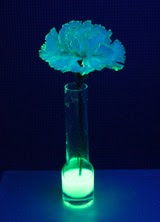glowing flower in dark room - interesting experiment anyone can do at home..
Use chemistry to make a real flower glow in the dark.
Glowing Flower - Method #1
- Test a highlighter pen to make sure it glows under black (fluorescent) light. Yellow is reliable, but some other colors glow brightly, too.
- Use a knife or saw to cut open the pen and expose the fibers which contain the ink. Remove the ink strip.
- Squeeze dye from the ink pad into a small amount of water.
- Trim the end of a flower so that it will be able to take up water. Place the flower in the water with the ink.
- Allow several hours for the flower to absorb the fluorescent ink. When the flower has taken in the ink its petals will glow under black light.
Glowing Flower - Method #2
Would you be surprised to learn that many flowers naturally glow under black or fluorescent light? Some insects, which pollinate the flowers, can see in the ultraviolet. It's usually white flowers that are ultraviolet-colored. You can accentuate the glow of white flowers under a black light by feeding them tonic water, which contains quinine. The quinine glows bright blue under a black light.- Pour some tonic water into a vase.
- Cut the end off of a flower so that it has a fresh surface.
- Allow several hours for the quinine to be incorporated into the petals of the flower.
- Turn on a black light and enjoy your flower.
Glowing Flower - Method #3
This is the easiest and quickest method and works even for deeply colored flowers.- Prepare glowing water using diet tonic water or any color of highlighter that you have established will glow under a black light. It's also possible to use thinned glowing paint.
- Find a glass or cup that is large enough to accomodate your flower. Fill this container with the glowing liquid.
- Invert the flower and immerse it in the liquid. Gently swish the flower around to dislodge any air bubbles, since areas with bubbles won't pick up the fluorescent or phosphorescent color.
- Allow your flower to absorb the dye. Just dipping the flower results in spotty coverage. If you want bright glowing flowers, allow the flowers to absorb the color directly into their petals for an hour or two. You can keep the stem of the flower hydrated by wrapping a bit of dampened paper towel around it.
- Remove the glowing flower from the liquid. You can place it in a vase filled with water or otherwise display it under a black light.
Tips for Making a Glowing Flower
- White or pale flowers work much better than flowers with deeply colored petals. The pigment in the dark colored flowers blocks nearly all the glowing light.
- You need fresh healthy flowers. Flowers that are nearly dead won't drink the water and won't glow. It's possible you might be able to inject the ink directly into the flower head, but wouldn't you rather just use a fresh flower?
- Certain flowers work better than others. Carnations and daisies work better than roses. Basically any flower you can dye with food coloring works well for making a glowing flower.


Comments
Post a Comment